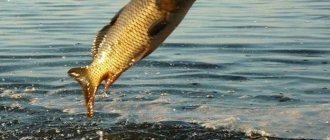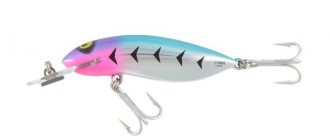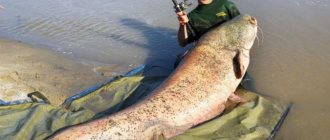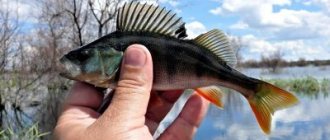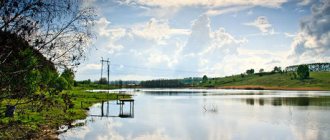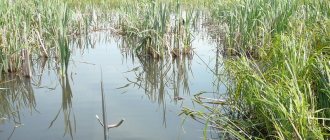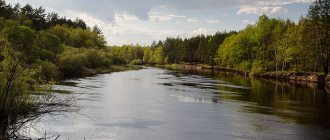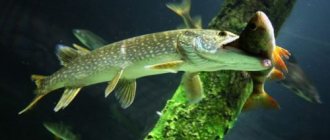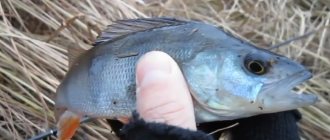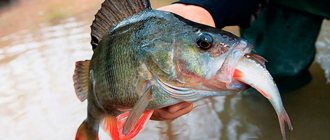Perch is a schooling fish that inhabits most reservoirs and rivers in Russia. I like to catch perch on the last ice and in early spring. After the deep winter season, the fish begin to actively bite. The predator spawns when the reservoir is completely free of ice and the water temperature reaches 8–10 degrees. During the mating season, the biting stops.
The predator stays in a flock in holes or snags with vegetation. The optimal depth when catching a predator is 1.5–5 meters.
In spring, active perch bite confidently, swallowing the bait deeply. The fishing rod is equipped with a fishing line 0.12–0.2 mm thick, to the end of which a jig, spinner or “baitless” is tied.
When does perch bite in early spring and how does the predator behave?
In March, after the deep winter, the perch bite intensifies and fishing becomes exciting. It happens that a striped fish refuses to bite on baitless tackle and prefers live bait (worm, raspberry, maggot, jig, “sandwich”). In April, the fish's bite intensifies and it delights fishermen with bites, greedily grabbing any offered bait.
In the northern regions of Russia, when the ice melts from the reservoir and the water warms up to a certain temperature, spawning begins. During this period of the predator's life, biting stops. The mating season lasts about 2 weeks, but may be delayed due to weather. Fish accumulate in large schools in spawning pits. The perch acquires a bright color: the stripes are more pronounced, and the fins become bright red. During spawning, perch spends a lot of energy and strength.
On the last ice, fish are successfully caught using baitless jigs. At this time, the perch begins its pre-spawning feast.
Search for a predator
In early spring, while the water is still cold, the fished object sticks to the bottom horizons and practically does not rise to the surface. Usually it hides from pike and other large predatory fish behind edges and small slopes, and can stand in hollows with a slow or swirling current. He is also attracted to snags and supports of hydraulic structures. High chances of success will be in places where tributaries and streams flow into the main channel. On lakes, stripers concentrate near local bottom anomalies: holes, grooves, tubercles and other irregularities.
Spawning begins in early April, when the water warms up to 7-8 degrees (approximately for most regions). River perch spawns first, since rivers are free of ice earlier. At this time, you can catch its lake brother, which is just getting ready to spawn. Small and medium-sized striped predators gather in large schools and migrate to spawning grounds - shallow, quiet areas where there is little or no current. Humpback whales, on the other hand, stay isolated or in a group of no more than a dozen individuals. The former should be looked for in shallow water with fallen branches and last year’s vegetation at the bottom, and the latter – at depths of up to 4 meters. The spawning of a large perch will begin a little later, but for now it behaves cautiously, rarely approaching the shore, so it is not easy to catch it.
Zhor of perch in spring
Zhor begins in March before spawning. The fish is “putting on fat” and preparing for the most important and responsible moment in its life. After spawning, already in open water, the perch again begins to actively feed on animal food.
The fish diet includes:
- leeches;
- caddisfly;
- bloodworm;
- fish fry;
- cuttlefish.
The post-spawning zhor lasts 7–14 days. If the water in the reservoir is cloudy, then they fish with bottom gear, float rods and rods with a side nod. Fishermen mainly use worms as bait. Spinning in muddy water is ineffective.
When the water becomes clear, you can try your luck in catching a predator using spoons and silicone. From personal experience, I have been convinced more than once that perch like silicone baits that are painted white, red and black.
Working silicone baits
Sometimes the striped predator is reluctant to bite on silicone baits. In this case, you need to experiment with wiring and try “jigging”. On a spinning rod with a test weight of up to 25 grams, bites can be felt well. When the bait touches the bottom, pause for a few seconds and make 3-4 turns of the reel. Usually the bass bite as soon as the bait starts moving.
If the fish refuses artificial baits, then try catching the predator on a fishing rod with a side nod and a jig. Use a dung worm, leech or caddis for bait. Look for fish in holes, oxbow lakes, and at river bends. Large perch prefer deep places with snags.
Where to catch perch
As you know, perch is a schooling fish. Small perches can form quite large schools, but large individuals of perches, the so-called humpbacks, hunt in small groups of up to 4 individuals or alone in open water and in winter. They are called humpbacks because with age, a hump appears on the back of the perch. The older the perch, the more noticeable this hump is.
Perch hunts on wide shallows with various vegetation. Its activity is easy to notice by the behavior of small fish that jump out of the water, trying to escape from the school of perch. If you encounter similar behavior of a fry, throw the bait a couple of meters further from the fireplace and immediately start retrieving, trying to lead the spoon as close to the surface of the water as possible. Large perches live in the depths, and only come out to shallow water early in the morning and late in the evening to hunt.
With the onset of autumn, perch begins to move to holes further from the shore. Moreover, the larger the minke whale, the farther from the shore it moves.
If you are fishing on a river, you should pay special attention to the pools behind the riffles. Perch loves such places very much and often gathers in them in huge schools. If you find such a flock, the bites will follow one after another. And due to high competition in such large schools, perch will attack almost any bait. It is also great to catch perch along the steep banks of rivers and lakes, where no one disturbs the peace of the predator.
You should not look for perch in fast currents; they don’t like them. Searches for perch must be organized in places with medium, weak currents or no current at all.
Where to look for promising places for perch fishing in the spring
By observing the behavior of fish in a reservoir, you can determine the fishing point. If you notice that there is a tree or bush in the pond, try fishing in this place. If the perch is active, then bites will not take long to arrive. From one spot you can catch several dozen large fish and experience the indescribable sensations of biting and fishing for the “striped robber.” The perch bites greedily, the fishing rod bends into an arc. The fisherman gets a lot of pleasure from such fishing. River bends are also the predator’s favorite places. It is advisable to find a dump.
On my next fishing trip, I was actively looking for perch. There were few bites, but the perch pecked greedily and confidently. When I noticed that there was a willow bush in the water, I decided to try my luck in this place. I fished with a 5-meter rod with a twitch, a 0.16 mm fishing line and a 0.7 gram lead jig.
The ice has disappeared from the reservoir. The water was cloudy. When lowering the jig to the bottom, I realized that this was a 2.5 meter hole. As soon as I raised the bait 10 cm from the bottom, a fish that looked like 300–400 grams bit. As it turned out during the fishing process, the perch in this place had finished spawning and was actively feeding on bloodworms. While fishing there were a lot of hooks and I lost about a dozen jigs. But the end result of the fishing was worth it!
perch fishing
Perch fishing. Perch is a diurnal fish and is caught from morning until dusk. In summer, perch is caught with a float rod or spinning rod, in winter - with spinners and jigs.
Perch is a wanderer, and this peculiarity in its behavior has been noticed: early in the morning, during feeding, it walks in schools not far from the shore to a certain place, and then returns back along the same road. In winter, anglers find these trails easily and line them up in long rows.
Perch is almost not afraid of noise, it is careless, greedy, and therefore becomes a frequent prey for anglers.
What gear to use for fishing and how to fish
Perch caught:
- float rod;
- winter fishing rod;
- spinning;
- Donka;
- fishing rod with a side nod.
Most fishing enthusiasts use a float rod. Some anglers use a worm, bark beetle, leech, caddis fly or maggot for bait. Others put live bait on the hook.
It is very interesting to watch the float when fishing for whitebait. If the perch grabs the bait, then you need to wait until the float disappears into the water column. Next comes the hooking. Perch prefers minnows and minnows as live bait.
On every fishing trip I experiment with bait. I equip one fishing rod with a worm, and put live bait on the other. Small perch usually bite on the worm. The bites on live bait are less frequent, but the size of the perch is pleasing!
A winter fishing rod is equipped with a jig, a balancer or a spinner. In spring the fish are active. You can try fishing with baitless jigs, but you need to choose the right bait to attract the attention of the perch. On ice I like to fish with a balance beam and vertical spoons.
They fish with a spinning rod when the water becomes clear. Turntables No. 2 and silicone baits about 5 cm long performed very well.
Donka works well in rivers with strong currents with a worm attached to the hook. You can attach several leashes with different baits to the main fishing line.
Fishing with a rod with a side nod is an exciting activity. You need to find a place with snags, algae, or a tree that has fallen into a pond. If a perch is present in such a place and is hungry, then it is simply obliged to bite!
Spinning fishing
Last spring I successfully caught large perch using a spinning rod. Rod test 4–25 grams. I felt the most cautious bites of a predator. But I would like to try an ultra-light spinning rod, spinners No. 0 and silicone baits with a 4–6 gram jig head. This will be the sensation from bites on “thin” tackle!
The choice of spinning rod must be approached responsibly. A good quality fishing rod should have a glossy surface. Two years ago, the rods were of good quality material. With this spinning rod I pulled out huge snags from the pond. There were no breakdowns.
I don’t recommend buying a spinning rod with a matte surface. These rods were enough for me for 3-4 fishing trips. A serious hook or bite from a large pike led to the breakage of the whip.
Fishing with a float rod
Float fishing is a fishing classic. Most anglers like to use float tackle. Bologna rod, fishing line 0.12-0.18, float, sinker and hook. The tackle is easy to assemble. The favorite bait for perch is a dung worm.
Donk fishing
At the end of March and beginning of April, you can try your luck in catching perch with a donka. This gear is used for fishing on rivers with strong currents. You can cast a weight of suitable weight yourself. I pour lead into a teaspoon. Using a drill with a diameter of 2 mm, I drill a hole where the fishing line will be inserted.
When catching perch in the spring with bottom tackle, I use two leashes with a diameter of 0.18 mm. I put a worm on one hook, and tie a fly on the other. The main fishing line is monofilament with a diameter of 0.25 mm.
Spinning equipment and fishing methods
Fishing in the spring months is characterized by different fishing methods and equipment used. The main differences between spring fishing and summer fishing are the predator’s preference for small-sized baits. In addition, it is better to avoid surface baits such as poppers or walkers.
In March
For March fishing for perch, the following leash rigs are used:
- Carolina rig - consists of a bullet sinker moving freely along the braided main line, a stopper bead and a long leash made of monofilament or fluorocarbon fishing line with a tied silicone bait on an offset hook;
- Retractable leash is a leash rig consisting of a triple swivel, to which is attached a piece of fishing line with a pear-shaped or stick-shaped sinker, a leash made of monofilament or fluorocarbon fishing line with a cross-section of 0.18-0.20 mm with a small silicone bait attached to the end, mounted on an offset hook.
The length of the leash in these rigs ranges from 80 to 120-130 cm and depends on the activity of the predator. When the activity of the perch is low, it is increased to 100-120 cm, but if the perch greedily grabs the bait on almost every cast, it is reduced to 70-80 cm.
The weight of the sinker is selected taking into account the depth at the fishing site and the strength of the current:
- For shallow reservoirs with depths of no more than 3 meters, the rigs are equipped with weights weighing from 6 to 8 g.
- For medium depths and small currents, sinkers weighing 10-12 g are used;
- At great depths or strong currents, sinkers weighing 12-15 g are used;
We recommend reading: Fishing for trout in winter on a platform
They catch perch with spaced-out rigs in March at the exits of pits, at the border of clear water and snags. You need to try in small local depressions.
A variety of wiring is used:
- a regular jig “step”;
- dragging along the bottom with sharp twitching and tossing;
- "for demolition";
- uniform;
- uniformly accelerated.
The bait is usually placed at the very bottom or not high above it.
For fishing with such equipment, light rods with a test weight of up to 15-17 g are used. The length of the blank is 210-240 cm. The reel for such equipment is small, 2000-2500 in size, with a front friction brake and 3-5 bearings. A thin 8-core braided cord with a cross-section of 0.1 mm is used as the main fishing line.
In April
In addition to lead rigs, in April perch is quite actively caught using microjigs.
To do this, use a light, fast-action “light” rod with a length of 210-240 cm with a sensitive glued-in tip of a bright color, a test of 0.5-5 years. This spinning rod is equipped with a small spinning reel measuring 500-1000.
A thin braided cord with a cross section of 0.06-0.08 mm is used as equipment. Also suitable is monofilament with a thickness of 0.14-0.16 mm, a leash made of durable transparent fluorocarbon with a micro-fastener at the end.
The wiring technique for micro and nanojigs differs little from conventional jigs.
For lead rigs and wobblers, a stiffer and less sensitive fishing rod is used. It is better to take a test up to 15 grams.
In May
Throughout May, small and medium-sized wobblers and spinners can be used for perch fishing.
They catch it at this time near the coastline on the border of clear water and thickets of young reeds, coastal snags, flooded trees or bushes. In this case, more rigid spinning rods are suitable, not only classic jigging rods, but also twitching rods.
At this time, the pike also begins to actively bite. In places where it is found in large quantities, a thin tungsten leader is added to the equipment.
Baits for perch in spring
Perch can be caught well with spinners, Blue Fox, and Rapala. Such products are expensive, but the price is justified. Fish bite on them very well. The spinner starts when it sinks to the bottom. Sometimes the perch bites at this moment. You can do slow wiring and the petal will still rotate around its axis.
Last year, the Aqua and Rapala wobblers performed well in open water. The perch refused to bite on other baits. We found a promising fishing spot. During the first retrieve, there was a powerful bite from a large perch, but there was a disappearance. Within an hour, 12 pieces were caught, each individual weighing about 1 kg. Small fish rarely pecked. Almost all the fish were released to grow up. Enjoyed fishing for spring perch!
I take a responsible approach to choosing silicone baits. But I don't pay attention to the manufacturer. I usually buy vibrotails 5–7 cm long. The body is white, and the back is painted black. I don’t know what this is connected with, but the predator likes these colors. Active perch in early spring readily grabs any bait.
It would be a good idea to rip open the belly of the perch and see what is in the stomach of the fish. If bloodworms are present in the digestive system, then try fishing with this bait. This method has helped me out while fishing more than once. It seems like you choose a suitable place, you understand that there is a perch there, but the fish bite uncertainly and rarely. I decided for myself that in 90% of cases the color of the jig does not affect the bite. Its purpose is to deliver bait to the fishing point.
Perch spawning
Typically, perch becomes sexually mature only in the third year of life. Spawning times are slightly different in different regions of the country. In the south, spawning begins at the end of February, in the middle zone - in April and early May, and in the northern regions - in May. Spawning occurs at a water temperature of 7-8°C. The perch spends the mating season in quiet places without current, with the presence of various kinds of obstacles. Perches rub against them, thereby speeding up the spawning process. The depth of the spawning area is 0.5-4 m depending on the age of the fish. The spawning period in rivers under favorable conditions lasts from 4 to 9 days. If the weather worsens, spawning may last for 18-20 days. On reservoirs, spawning lasts longer; it takes place in two stages. The second breeding period occurs at a water temperature of 10-18°C.
What determines the bite and success of spring perch fishing?
The spring perch bite depends on weather conditions. If it starts to rain, you can stop fishing. From personal experience I was convinced that perch does not bite in rainy weather. The ideal time to fish is early morning and evening. At this time, the fish is actively searching for food.
Fishing is an activity that I fell in love with since childhood. As a child, my father and I often went out of the house to fish. I was always looking for fish very actively. I tried to fish in the most inconvenient places. I was always pleased with the result. I rarely came home without fish. Experience comes with age.
Now I know that perch loves depth, snags and vegetation. In these places it is successfully caught with live bait. Active perch sometimes bites on a jig with a red woolen thread. But here it is important to fish with a retrieve so that the bait is always in motion, imitating a small fish. It happens that a pike bites on this tackle, but it often bites the fishing line.
I go fishing often. It amazes me that fishermen leave a lot of garbage behind. I collect all the garbage in bags, bring it home and dispose of it. Gentlemen, fishermen, understand one important rule: “clean is not where they clean, but where they don’t litter.”
Early spring
In suburban reservoirs, the mouths of streams, rivers and canals are the first to be cleared of ice (Fig. 1) . In these areas, under the influence of the March sun and the wind, which constantly mixes the water masses, the water temperature will always be slightly higher than under the ice. Due to these more favorable conditions, numerous flocks of all kinds of “leucorrhoea” will begin to move here. And they, in turn, will be followed by predators, the most numerous of which will be perch. True, mostly small. And bites of decent, for 200 - 300 g, striped fish occur extremely rarely at this time.
As air temperatures rise, the coastline warms further, and it is there that the ice sheet melts faster. And as soon as the ice moves 10 - 20 m from the shore, I begin fishing such places in the hope of an early spring humpback bite. These local areas are additionally attractive due to the presence of decent depth at the boundary of ice and open water.
As a rule, these are smooth channel edges, gentle entrances to and exits from pits, as well as underwater tables that can be reached during shore fishing (Fig. 2) . The temperature of the middle layers of the water column is still quite low at this time due to the melting of ice and the striped robber now sticks to deeper places. My working depths in early spring range from three to six meters, which is where you can now count on a bite from a large perch.
Let me give you an interesting example from personal practice. Outside, it’s mid-March, quite warm. Due to the early onset of spring, the destruction of ice on reservoirs began to occur at an accelerated pace. And as a friendly group, we decided to open the jigging season at one of the suburban reservoirs. Having arrived there, we found that the place where the river flows into the reservoir is almost completely occupied by numerous fishermen.
Floaters catch bream and roach, spinning anglers catch small perches on the “Discharge Leash”. My comrades squeezed in with difficulty among the fishing fraternity, but I was not happy with this situation - I don’t like fishing in a crowd. With a set of gear for light jigging, I set out to explore. Half a kilometer from the river mouth I discovered a local area where the ice had moved 30 - 50 m from the shore - this is already interesting. Since, due to the melting ice, the transparency of the water did not exceed 20 - 30 cm, I installed an S-Shad Tail 2.8 (Chartreuse Red) from Lucky John , and began casting it to the very edge of the muddy water. ice.
Soon, almost on release, a barely perceptible bite occurred. Instantly hooked - and the weighty striped robber found himself on the shore. A start has been made, a photo as a souvenir - I release the predator into its native element. Over the next few hours, from this promising area about two hundred meters long, I caught nine more plump perches and one pike weighing 3 kg. But by lunchtime, the north wind, which had dispersed a decent wave, began to crumble the remnants of the last ice, which caused a loud noise in the reservoir - the already minimal activity of the predator came to naught.
He returned to his comrades, and during this time they caught only a dozen small “sailors” and two unqualified pike. What a fun opening of the season we had!
In early spring, you should not count on massive bites of perch weighing 150 g and above from one promising place. Usually no more than three bites occur at a point, then it is better to try to detect an active predator in a new place.
Waiting tactics - fishing for a long time at one, albeit promising, point - will not work. I manage to achieve the best results at this time in cloudy weather or on days with partly cloudy skies, when there is a calm wind situation on the reservoir. The optimal period of daylight, when the perch will delight you with its bites, can be considered the interval from 12 to 16 hours.
After some time, the ice will melt throughout the entire water area of the reservoir, and new areas of the reservoir will become available to the jig. Decent perch can be found on depressions of the bottom, smoothly descending from the shore deep into the reservoir (Fig. 3) .
We cannot discount the riverbed areas of the reservoir (Fig. 4) , which the predator regularly visits at this time. The extended holes that follow the contours of the coastline are also of interest.
The most promising places in the water area of the reservoir in early spring can be considered local slides and banks (Fig. 5) , which can be reached when fishing from the shore.
The attractiveness of these bottom anomalies is increased by their location in large holes or the channel part of the reservoir. Given certain factors that prevailed at the time of fishing, primarily the water temperature at a particular point and weather components, the striped robber can be found both at the base of such bottom elevations and on the steep slopes of hills or even at their tops.
Now perch shows its activity in the form of so-called outings, the number of which and their duration directly depend on the dynamics of weather conditions a day or two before departure, at the time of fishing and a day or two after it. Here I would like to note one very important and interesting feature of the predator’s behavior in early spring.
If for several days before a specific departure the nights were quite cold, even with minimal frosts, and the night before the air temperature increased significantly, then the first release of the perch can be expected from dawn. Immediately after the ice melts, the best results can be achieved in calm wind conditions on the reservoir simultaneously with variable or continuous cloudiness.
Posting methods
Experienced fishermen claim that on sunny days in April and May, good results are shown by fast, sharp, that is, active play. During cold weather, perch become slower and respond better to smooth movements and not sudden jerks. So keep an eye on the water temperature and weather, select the optimal size of bait and experiment.
Also read our interesting articles on the topic of spinning:
- The best budget spinning rods
- Budget spinning reels
- Budget reels for ultralight
- Spinning equipment
- Rod materials
- Offset hooks
- Floating silicone baits
- DIY silicone baits
- Spinning tackle
